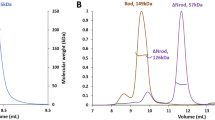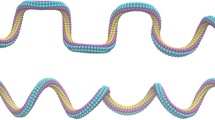Abstract
Vimentin coiled-coil alpha-helical dimers are elementary protein building blocks of intermediate filaments, an important component of the cell’s cytoskeleton. All intermediate filament dimers feature a highly conserved ‘stutter’ region, a sequence of amino acids that interrupts the superhelical coiled-coil arrangement of the two alpha-helices, leading to a parallel arrangement of the alpha-helices in this region. Earlier studies have suggested that the stutter plays an important role in filament assembly. Here we show that the stutter also has a significant effect on the mechanical behavior of vimentin dimers. We develop an Extended Bell Model to provide a theoretical description of the unfolding behavior of coiled-coil structures, capable of capturing different molecular geometries and loading rates. The Extended Bell Model predicts that the stutter represents a molecular defect at which unfolding occurs at lower forces than in the rest of the protein. Our studies suggest that the presence of the stutter leads to a softer structure with more homogeneous plastic strain distribution under deformation. The predictions by the Extended Bell Model are confirmed by large-scale MD simulations of three model systems: Two parallel alpha-helices, a coiled-coil dimer, as well as a coiled-coil dimer with a stutter. The simulations prove that in agreement with the prediction based on our Extended Bell Model, the stutter represents the locations at which the protein structure has the least resistance to unfolding. We discuss the implications of this molecular architecture in terms of its biological function.








Similar content being viewed by others
References
Alberts B et al. (2002) Molecular biology of the cell. New York: Taylor and Francis.
Rose A, Meier I (2004) Scaffolds, levers, rods and springs: diverse cellular functions of long coiled-coil proteins. Cell Mol Life Sci 61(16):1996–2009.
Strelkov SV, Herrmann H, Aebi U (2003) Molecular architecture of intermediate filaments. Bioessays 25(3):243–251.
Maccallum JL et al. (2007) Hydrophobic association of {alpha}-helices, steric dewetting, and enthalpic barriers to protein folding. Proc Natl Acad Sci U S A 104(15):6206–6210.
Burkhard P et al. (2000) The coiled-coil trigger site of the rod domain of cortexillin I unveils a distinct network of interhelical and intrahelical salt bridges. Structure with Folding & Design 8(3):223–230.
Gruber M, Lupas AN (2003) Historical review: another 50th anniversary—new periodicities in coiled coils. Trends Biochem Sci 28(12):679–685.
McLachlan AD, Karn J (1983) Periodic features in the amino-acid-sequence of nematode myosin rod. J Mol Biol 164(4):605–626.
Brown JH, Cohen C, Parry DAD (1996) Heptad breaks in alpha-helical coiled coils: stutters and stammers. Proteins 26(2):134–145.
Strelkov SV et al. (2002) Conserved segments 1A and 2B of the intermediate filament dimer: their atomic structures and role in filament assembly. EMBO J 21(6):1255–1266.
Herrmann H, Aebi U (1999) Intermediate filament assembly: temperature sensitivity and polymorphism. Cell Mol Life Sci 55(11):1416–1431.
Parry DAD (1978) Fibrinogen—preliminary-analysis of amino-acid sequences of portions of alpha-chains, beta-chains and gamma-chains postulated to form interdomainal link between globular regions of molecule. J Mol Biol 120(4):545–551.
Akkermans RLC, Warren PB (2004) Multiscale modelling of human hair. Philos Trans R Soc Lond Ser A Math Phys Sci 362(1821):1783–1793.
Cieplak M, Hoang TX, Robbins MO (2002) Thermal folding and mechanical unfolding pathways of protein secondary structures. Proteins 49(1):104–113.
Rohs R, Etchebest C, Lavery R (1999) Unraveling proteins: a molecular mechanics study. Biophys J 76(5):2760–2768.
Bornschlogl T, Rief M (2006) Single molecule unzipping of coiled coils: sequence resolved stability profiles. Phys Rev Lett 96(11):118102.
Wang N, Stamenovic D (2002) Mechanics of vimentin intermediate filaments. J Muscle Res Cell Motil 23(5–6):535–540.
Smith TA et al. (2003) Modeling alpha-helical coiled-coil interactions: the axial and azimuthal alignment of 1B segments from vimentin intermediate filaments. Proteins 50(2):207–212.
Kreplak L, Aebi U, Herrmann H (2004) Molecular mechanisms underlying the assembly of intermediate filaments. Exp Cell Res 301(1):77–83.
Fudge DS et al. (2003) The mechanical properties of hydrated intermediate filaments: Insights from hagfish slime threads. Biophys J 85(3):2015–2027.
Fudge DS, Gosline JM (2004) Molecular design of the alpha-keratin composite: insights from a matrix-free model, hagfish slime threads. Proc R Soc Lond B Biol Sci 271(1536):291–299.
Moir RD, Spann TP (2001) The structure and function of nuclear lamins: implications for disease. Cell Mol Life Sci 58(12–13):1748–1757.
Wilson KL, Zastrow MS, Lee KK (2001) Lamins and disease: insights into nuclear infrastructure. Cell 104(5): 647–650.
Coulombe PA et al. (2000) The ‘ins’ and ‘outs’ of intermediate filament organization. Trends Cell Biol 10(10):420–428.
Kreplak L et al. (2005) Exploring the mechanical behavior of single intermediate filaments. J Mol Biol 354(3):569–577.
Kiss B, Karsai A, Kellermayer MSZ (2006) Nanomechanical properties of desmin intermediate filaments. J Struct Biol 155(2):327–339.
Omary MB, Coulombe PA, McLean WHI (2004) Mechanisms of disease: intermediate filament proteins and their associated diseases. N Engl J Med 351(20):2087–2100.
Schietke R et al. (2006) Mutations in vimentin disrupt the cytoskeleton in fibroblasts and delay execution of apoptosis. Eur J Cell Biol 85(1):1–10.
Herrmann H, Aebi U (2004) Intermediate filaments: molecular structure, assembly mechanism, and integration into functionally distinct intracellular scaffolds. Ann Rev Biochem 73:749–789.
Ackbarow T, Buehler MJ (2007) Superelasticity, energy dissipation and strain hardening of vimentin coiled-coil intermediate filaments: atomistic and continuum studies. J Mater Sci 42:8771–8787.
Bell GI (1978) Models for specific adhesion of cells to cells. Science 200(4342):618–627.
Nelson MT et al. (1996) NAMD: a parallel, object oriented molecular dynamics program. Int J Supercomput Appl High Perform Comput 10(4):251–268.
MacKerell AD et al. (1998) All-atom empirical potential for molecular modeling and dynamics studies of proteins. J Phys Chem B 102(18):3586–3616.
Lu H et al. (1998) Unfolding of titin immunoglobulin domains by steered molecular dynamics simulation. Biophys J 75(2):662–671.
Humphrey W, Dalke A, Schulten K (1996) VMD: Visual molecular dynamics. J Mol Graph 14(1):33.
Schwaiger I et al. (2002) The myosin coiled-coil is a truly elastic protein structure. Nat Mater 1(4):232–235.
Currey JD (2002) Bones: structure and mechanics. Princeton, NJ: Princeton University Press.
Barthelat F et al. (2007) On the mechanics of mother-of-pearl: a key feature in the material hierarchical structure. J Mech Phys Solids 55(2):306–337.
Heslot H (1998) Artificial fibrous proteins: a review. Biochimie 80(1):19–31.
Ball P (1997) Made to measure: new materials for the 21st Century. Princeton, NJ, USA: Princeton University Press.
Acknowledgements
TA acknowledges the support of the German National Academic Foundation and the Dr.-Juergen-Ulderup Foundation. This research was partly supported by the Army Research Office (ARO), grant number W911NF-06-1-0291 (program officer Dr. Bruce LaMattina) and a National Science Foundation CAREER Award (program officer Dr. Jimmy Hsia). We acknowledge fruitful discussions with Professor Harald Herrmann (University of Heidelberg, Germany) and Professor Laurent Kreplak (University of Basel, Switzerland). We also acknowledge continuous interest and support by Professor Lothar Gaul (University of Stuttgart, Germany) in our research.
Author information
Authors and Affiliations
Corresponding author
Rights and permissions
About this article
Cite this article
Ackbarow, T., Buehler, M.J. Molecular Mechanics of Stutter Defects in Vimentin Intermediate Filaments. Exp Mech 49, 79–89 (2009). https://doi.org/10.1007/s11340-007-9100-6
Received:
Accepted:
Published:
Issue Date:
DOI: https://doi.org/10.1007/s11340-007-9100-6




